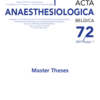Risk factors of Intensive Care Unit-Acquired Weakness: a single center retrospective analysis
Critical illness; muscle weakness; poly-neuropathies; sepsis
Published online: Apr 21 2022
Abstract
ICU acquired muscle weakness (ICU-AW) is a central feature of protracted critically ill patients. Severity of critical illness, interventions, such as the administration of neuromuscular blocking agents and aminoglycosides, and markers in the blood, such as hyperglycemia, have been associated with ICU-AW. Prediction models for ICU-AW have been disappointing. This retrospective analysis aimed to investigate known risk factors of ICU-AW in a single center 36 bed ICU of a non-university teaching hospital.
ICU-AW was diagnosed by the MRC-SUM test in awake patients (score <48). Risk factors, derived from the literature, were classified in three classes (patient characteristics, ICU interventions and laboratory variables). Only values, known within the first two days of ICU stay were taken into account. The most relevant factors concerning ICU-AW were selected by comparing patients with and without ICU-AW, stratified by the three classes.
Patient characteristics were most discriminative between patients with and without ICU-AW. Only the need for endotracheal intubation for at least 2 days was a relevant intervention associated with ICU-AW. None of the laboratory variables differed between patients with and without ICU-AW. Female gender (p<0.001), unplanned admission (p=0.007), suspected sepsis (p=0.006), and severity of acute critical illness (APACHE IV score) on admission (p<0.001) were different in patients with ICU- AW. In the multivariate logistic regression model female gender (odds ratio 2.50, 95%CI 1.63-3.84, p<0.001), APACHE IV score (odds ratio 1.01, 95%CI 1.01-1.02, p=0.029) and need for endotracheal intubation for at least 2 days (odds ratio 2.14, 95%CI 1.31-3.48, p=0.002) remained independent risk factors of ICU-AW. However, their discriminative power for ICU-AW had only an AUROC of 0.681 (95%CI 0.631-0.730) (p<0.001). Patient characteristics on admission appeared to differ most in patients with ICU-AW, in compared to patients without. Female gender, severity of critical illness and prolonged need of intubation are strongly associated with ICU-AW.
